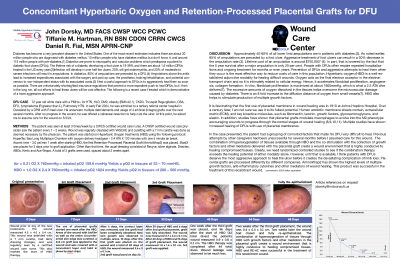Case Series/Study
(CS-038) Concomitant Hyperbaric Oxygen and Retention-processed Placental Grafts for Dfus

develop a diabetic foot ulcer (DFU), with about 1.6 million DFUs treated each year. These wounds are
very susceptible to infection with 20% of these infections leading to amputation. Sadly, the 5-year
morbidity of lower limb amputees is over 80%. Additionally, amputations can have a serious economic
impact due to increased expenditures on surgery, post operative care, prosthetics, rehabilitation, etc. It is
imperative to treat DFUs with an aggressive approach to aid in quicker healing, avoid amputation and
unnecessary costs. A combination of placental membrane grafts as wound coverings with hyperbaric
oxygen (HBO) therapies is an example of such an aggressive approach. This case report follows a patient
treated with HBO and retention-processed full-thickness amnion/chorion (RE-AC) placental grafts
resulting in great success and a fully recovered wound.
Methods:
A 72-year-old, male patient with a past medical history of obesity (BMI=42.1), Type 2 Diabetes,
lymphedema with extensive dermatosclerosis, non-compliant OSA with pulmonary hypertension
developed a R heel ulcer. During and after hospitalization, the patient underwent multiple debridements
and 4 artificial grafts, with no success. The patient was started on a novel approach of HBO therapy and
RE-AC placental grafts. HBO dives were 5 days a week and dressing changes were completed daily. It is
important to note this patient had significant drainage due to his lymphedema. The treatment was
concluded after 44 total HBO therapies and 3 RE-AC placements, resulting in complete re-
epithelialization.
Results: wanted to put a sequence of pictures here to visually show the progress
Discussion:
Discussion – Approximately 40-60% of all lower limb amputations are in patients with diabetes.(3). As noted earlier, 85% of amputations are preceded by a foot ulcer. Aggressive treatment of foot ulcers can result in a 50% decrease in the amputation rate (3). Lifetime cost of an amputation is around $750,000* (4).
In the case presented, the patient had a grouping of comorbid factors that made his DFU very difficult to
heal. Previous attempts by other caregivers had been unsuccessful for several months. The combination of
hyperoxygenation of tissues through HBO with growth factors and other mediators in the retention-
processed RE-AC placental graft create a wound environment that is highly conducive to healing
compromised tissues. In this patient, HBO and RE-AC were very successful in the treatment of this
recalcitrant wound.

.jpg)